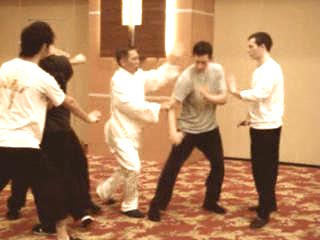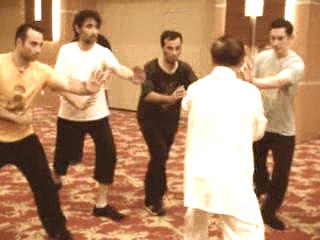SINGLE UNARMED AGAINST MULTIPLE UNARMED
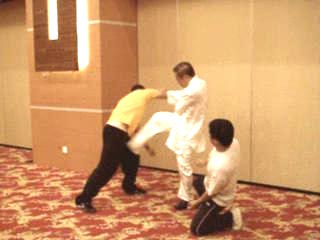
Grandmaster Wong demonstrates an important principle when fighting against multiple attackers
Not a Good Counter
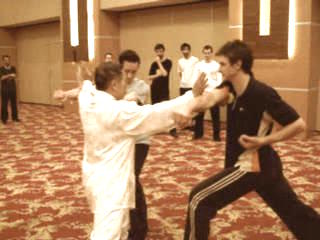 Grandmaster Wong successfully counters against two attackers, but it is not a good counter. Do you know why? And do you also know that these two attackers are trained to attack in multiple fashion?
Grandmaster Wong successfully counters against two attackers, but it is not a good counter. Do you know why? And do you also know that these two attackers are trained to attack in multiple fashion?
Two Fists Are No Match against Four Hands
 This is an example of the kungfu saying that "two fists are no match against four hands." If you are attacked by two or more people at the same time, how would you overcome this problem?
This is an example of the kungfu saying that "two fists are no match against four hands." If you are attacked by two or more people at the same time, how would you overcome this problem?
Effective Counter against Two Simultaneous Attackers (1)
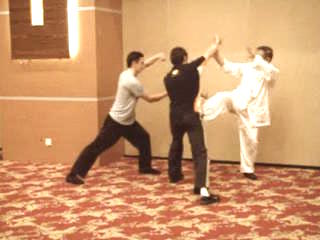 Here Grandmaster Wong effectively counter two simultaneous attackers, thus overcoming the problem of "two fists are no match against four hands".
Here Grandmaster Wong effectively counter two simultaneous attackers, thus overcoming the problem of "two fists are no match against four hands".
Effective Counter against Two Simultaneous Attackers (2)
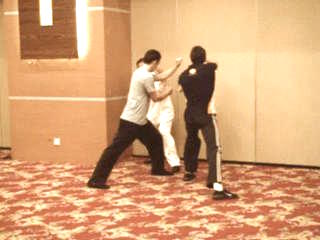 Grandmaster Wong demonstrates another way to overcome two simultaneous attackers. The same principle is used although the actual counter movements are different. Do you know what this principle against multiple attacks is?
Grandmaster Wong demonstrates another way to overcome two simultaneous attackers. The same principle is used although the actual counter movements are different. Do you know what this principle against multiple attacks is?
Effective Counter against Two Simultaneous Attackers (3)
 In countering multiple attacks, besides the important principle dealing with movements illustrated in
two other video clips, there is another important principle dealing with striking illustrated here. Do you know what it is?
In countering multiple attacks, besides the important principle dealing with movements illustrated in
two other video clips, there is another important principle dealing with striking illustrated here. Do you know what it is?
Overwhelmed by Four Simultaneous Attackers
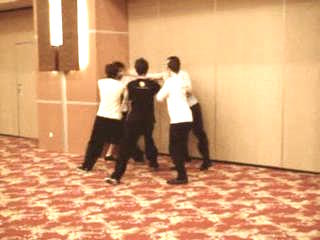 Handling four simultaneous attackers is not similar to handling three. It is not just a matter of an extra attacker, as in the case of increasing from two to three attackers. Do you know why?
Handling four simultaneous attackers is not similar to handling three. It is not just a matter of an extra attacker, as in the case of increasing from two to three attackers. Do you know why?
Sealing the Escape Route
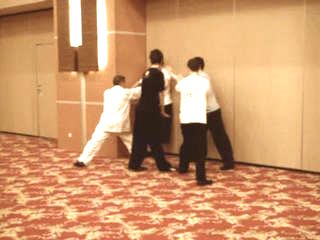 Instead of joining in the multiple attack, the fourth attacker, who is usually the leader of the attacking team, seals the escape route of the victim. How could you overcome this problem when faced with four simultaneous attackers?
Instead of joining in the multiple attack, the fourth attacker, who is usually the leader of the attacking team, seals the escape route of the victim. How could you overcome this problem when faced with four simultaneous attackers?
Using a Shield
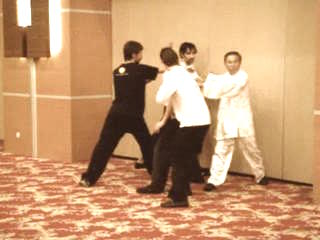 One effective counter against four or more attackers is to use a shield. Here Grandmaster Wong uses the third attacker as a shield while striking down the fourth attacker who attempts to seal the escape route.
One effective counter against four or more attackers is to use a shield. Here Grandmaster Wong uses the third attacker as a shield while striking down the fourth attacker who attempts to seal the escape route.
Using Entanglement
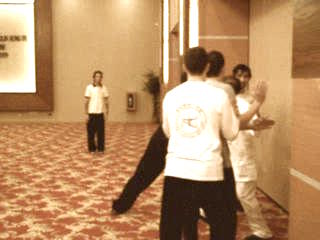 Another effective counter is to use entanglement, i.e. entangle the attackers so that they cannot attack simultaneously. Notice that the countering movements are different. Here Grandmaster Wong goes into the midst of the attackers to entangle them. This, of course, demands, great skills.
Another effective counter is to use entanglement, i.e. entangle the attackers so that they cannot attack simultaneously. Notice that the countering movements are different. Here Grandmaster Wong goes into the midst of the attackers to entangle them. This, of course, demands, great skills.
Fighting with a Fort Behind
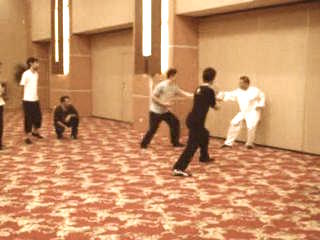 There are two main strategies in handling multiple attacks, namely "back-wall battle" and "dodge-hit battle". Here Grandmaster Wong demonstrates the strategy of "back-wall battle", which is also poetically described as "battling with the fort behind".
There are two main strategies in handling multiple attacks, namely "back-wall battle" and "dodge-hit battle". Here Grandmaster Wong demonstrates the strategy of "back-wall battle", which is also poetically described as "battling with the fort behind".
Entering a Herd of Sheep
 Here Grandmaster Wong demonstrates the strategy of "dodge-hit battle", which is also poetically described as "tiger in a herd of sheep".
Here Grandmaster Wong demonstrates the strategy of "dodge-hit battle", which is also poetically described as "tiger in a herd of sheep".
Combat is Alive and Full of Variations
 The classification into two main strategies is for convenience. We must of course not be a slave to rigid classification. Real combat is alive, full of changes and variations. We may, for example, start with a fort behind us, then enter a herd of sheep.
The classification into two main strategies is for convenience. We must of course not be a slave to rigid classification. Real combat is alive, full of changes and variations. We may, for example, start with a fort behind us, then enter a herd of sheep.
Overwhelmed by Multiple Attackers
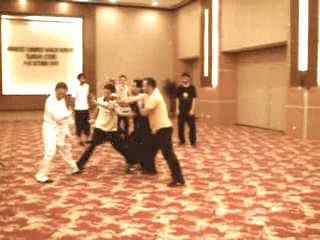 Just retreating, which most untrained people would do, would result in being overwhelmed by multiple attackers.
Just retreating, which most untrained people would do, would result in being overwhelmed by multiple attackers.
Overcoming Multiple Attacks
 Applying the principles of multiple attacks will enable you to overcome the attackers. Can you tell the two principles involved here?
Applying the principles of multiple attacks will enable you to overcome the attackers. Can you tell the two principles involved here?
Overcoming Three Simultaneous Attackers
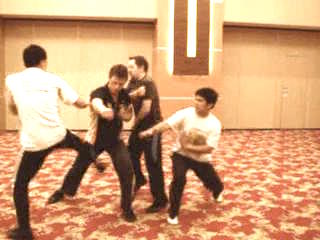 Can you tell what important principles Sifu Zhang Wuji employs in overcoming three simultaneous attackers?
Can you tell what important principles Sifu Zhang Wuji employs in overcoming three simultaneous attackers?
Overcoming Four Simultaneous Attackers
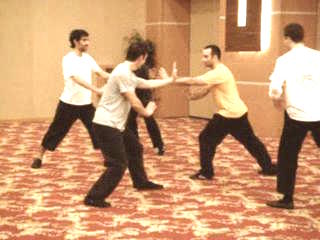 Here Sifu Eugene overcomes four simultaneous attackers. Do you know why four trained attackers is not the same as just adding an extra attacker to three. Sifu Eugene has to use an extra principle besides the two principles used by Sifu Zhang Wuji. Do you know what this extra principle is?
Here Sifu Eugene overcomes four simultaneous attackers. Do you know why four trained attackers is not the same as just adding an extra attacker to three. Sifu Eugene has to use an extra principle besides the two principles used by Sifu Zhang Wuji. Do you know what this extra principle is?
Trained and Untrained Multiple Attackers
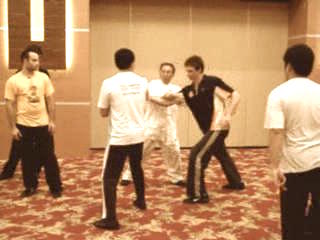 Using multiple shields is useful when there are four or more simultaneous attackers. Take note that these attackers are trained in multiple attacks. Handling multiple attackers who are untrained in multiple attacks is much easier.
Using multiple shields is useful when there are four or more simultaneous attackers. Take note that these attackers are trained in multiple attacks. Handling multiple attackers who are untrained in multiple attacks is much easier.
Overcoming Five Trained Simultaneous Attackers (1)
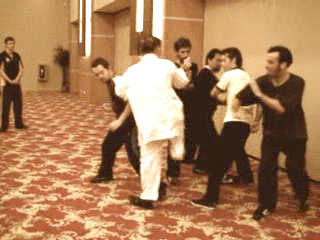 Grandmaster Wong demonstrates and explains how to overcome five trained simultaneous attackers. Can you remember the crucial difference between multiple attackers who are trained and who are untrained?
Grandmaster Wong demonstrates and explains how to overcome five trained simultaneous attackers. Can you remember the crucial difference between multiple attackers who are trained and who are untrained?
Overcoming Five Trained Simultaneous Attackers (2)
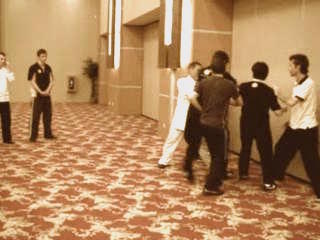 Here is another example of how to overcome five trained simultaneous attackers. There is some difference in approach, though the main principles are the same. Can you see what the difference is?
Here is another example of how to overcome five trained simultaneous attackers. There is some difference in approach, though the main principles are the same. Can you see what the difference is?
Striking First to Secure Victory
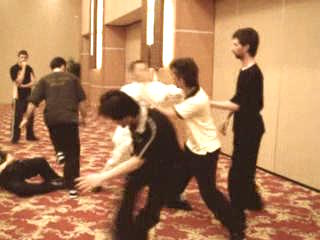 Here Grandmaster Wong uses the strategy of Striking First to Secure Victory, known in Chinese (Cantonese) as sin ha sau wei keong.
Here Grandmaster Wong uses the strategy of Striking First to Secure Victory, known in Chinese (Cantonese) as sin ha sau wei keong.
Using Shields and Entanglement
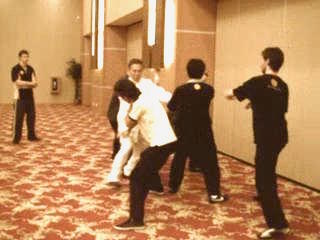 Here Grandmaster Wong employs a different strategy, using shields and entanglement as well as dodge and hit.
Here Grandmaster Wong employs a different strategy, using shields and entanglement as well as dodge and hit.
Overwhelming by Multiple Attackers
Explaining the Priniciples
Demonstrating how to Handle Multiple Attacks
Single Unarmed against Multiple Armed from Wong Kiew Kit on Vimeo.
LINKS


